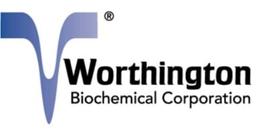Collagenase
Crude collagenases are widely used in enzymatic primary cell isolation and tissue dissociation procedures. Most researchers employ either crude collagenase preparations such as Types 1, 2, 3, and 4 or chromatographically purified collagenase (the latter usually combined with secondary enzymes such as elastase, hyaluronidase, etc). For best results, the precise mixture of proteolytic activities must be tailored to the tissue to…

The supplier does not provide quotations for this product through SelectScience. You can search for similar products in our Product Directory.
Collagenase is dependable, and available by lot
Digest tissues in flow cytometry preparation
I appreciate Worthington's commitment to lot sampling and their focus on these tissue dissociation products. We use their collagenase II for digesting adult mouse myocardial tissue.
Review Date: 28 Feb 2023 | Worthington Biochemical Corp.
Good quality reagen for isolating endothelial cells.
Endothelial cell isolation
I have been using Collagenase Type 3 since I came to my current lab for isolating endothelial cells from umbilical cord veins and saphenous veins. Recently the color of the product has changed from dark brown to light brown but the activity is the same. I have isolated endothelial cells successfully from more than 50 veins in the last 3 years and banked them which would never be possible without good quality reagents.
Review Date: 2 Dec 2019 | Worthington Biochemical Corp.
Crude collagenases are widely used in enzymatic primary cell isolation and tissue dissociation procedures. Most researchers employ either crude collagenase preparations such as Types 1, 2, 3, and 4 or chromatographically purified collagenase (the latter usually combined with secondary enzymes such as elastase, hyaluronidase, etc). For best results, the precise mixture of proteolytic activities must be tailored to the tissue to be dissociated. Correlations between type and effectiveness with different tissues have been good, but not perfect, and may be dependent partly on parameters of use and objectives as well as lot-to-lot variations.
Type 1: Crude collagenase has the original balance of collagenase, caseinase, clostripain and trypic activities
Type 2: Contains higher relative levels of protease activity, particularly clostripain
Type 3: Contains lowest levels of secondary proteases
Type 4: Designed to be especially low in tryptic activity to limit damage to membrane proteins and receptors


















